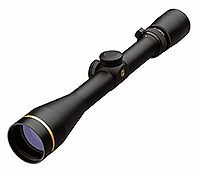How Rifle Scopes Work
Article Posted: November 1, 2012
Scopes are arguably one of the most instrumental advances in modern weaponry we have at our fingertips other than bullet-grain capacity, range and velocity. Of course, let's not forget that iron sights have been around since the early days of firearms, but to have the capability of precision magnification and laser-dot technology that has arrived with the advent of these newer scopes has made accuracy a near-intuitive experience. But let's say you are new to the field of hunting or ballistics, what do you need to know about scopes to help get you consistently hitting near the bulls eye with increased accuracy?
Let's take a look at a few, must know functions of the basic rifle scope.
- Optics: Inside the scope are a complex set of mechanisms; namely lenses, magnification rings and adjustment dials. Nearest the shooter's eyes are the ocular lens which sits in the eye piece, traveling towards the middle of the scope is the power ring, elevation adjustment (which adjusts for horizontal) windage adjustment (adjusts for vertical alignment) the windage bell and the objective lens, the lens furthest away from the eye. How optics work is that light passes through the objective lens, focusing on a point inside the scope. This is where the ocular lens (nearest your eye) magnifies this light forming the image that the lens is focused upon. Your windage and elevation adjusters will bring the image in top/bottom or right/left where you can view the image in the reticle or crosshairs. When you center that image in the middle of the crosshairs this will show the shooter where the bullet is intended to strike.
- Parallax: Parallax is a phenomenon that occurs when you have your sights changed based upon your head's lateral position; that is your target has shifted without touching your scopes position. Most rifle companies that sell high-power scopes will come with parallax adjustment so that the shooter will not have to compensate for the error caused by this optical illusion. Parallax is much more apparent the further your distance, something a novice long range shooter should take into account.
- Non-magnification scopes: When people think of scopes, one of the first thoughts is magnification, which of course, many scopes do indeed have. However, with today's modern technology there are other options that can help improve your accuracy, this is where a red dot scope could come in handy. Without the use of magnification, the LED light shows up in the center of the lens to provide the shooter an exact location of the bullet's intended target. This is not seen by anyone other than the shooter, as it is restricted to the inside of the scope. Virtually parallax-free, this would be a good scope for use by target shooters or those in law enforcement.
Scopes have no doubt, helped improve the average hunter or law enforcement officer with its powerful magnification capabilities and dot-sight accuracy. However, no matter the cost, power and increased technological capacities, you will never improve your accuracy unless you get out and consistently practice. With a basic understanding of optics, you can choose the scope that best fits your use of that newer firearm. Whether for hunting or marksmanship, a quality scope can make all the difference.
Travis Brenson is an avid hunter and marksman who enjoys the big Texas outdoors and appreciates a good venison steak. When he's not in his deer stand he's working for Scopesnmore.com, home of the best deals on scopes.
Contributing Author: Travis Brenson
Related Articles
Please like, share, favorite, bookmark, and comment. Thank You.
Main Menu
Original Articles
- New 25+1 Capacity Shotgun!
- Hudson H9 American Made 9mm
- How To Build A Mud Hut
- Pistol Looks Like Cell Phone
- 45 ACP vs 9mm Luger
- Best 9mm Carbines
- Mall Ninja Xtreme Zombie Carbine!
- 5 Alternative Range Bags for Pistols
- Best 45 ACP Carbines
- 5 Dirt Cheap Guns $170 to $260
- Muslim Free Shooting Range?
- How To Clean A Rifle
- 3 Good 300 AAC Blackout Reviews
- Top 5 Guns for Women
- How to Really Shoot A Pistol
- Worlds Best 9mm Handgun
- 5 Great Gun Safes (Options)
- 9mm vs 40 S&W Summary + Ballistics
- Red Oak, White, or Chestnut for Deer Herd?
- Bullets for Barter Post Collapse
- Funny Pro Gun Sayings
- 5 Strange Handguns You Don't Need
- 3 Great .22LR / 410 Survival Rifles
- American Rifles | The Original ARs
- 600 Round Glock Magazine
- 10mm vs 40 Summary and Ballistics
- How Important is "Shot Placement"?
- 10 Item First Aid Kit Checklist
- 10 Gun Lights for Home Defense
- How to Make a Stove Hobo Style!
- Most Basic Survival Food List Ever
- Best Handguns for Women
- Make Homemade Mosquito Trap
- Lets make a Sawed-Off Shotgun!
- Man Brings Knife to Gun Fight (Funny)
- Gun Store Etiquette (Proper vs Improper)
- 10 Simple Home Security Tips
- SIG-Sauer vs Glock
- Legal Length of Shotguns and Rifles
- 9mm Pocket Pistols
- Glock 17/19/26 Operating Procedures
- 10 Conceal Carry Tips (Funny)
- Understanding the 2nd Amendment
- Choose Your Own Crime Stats
- After You Dial 911 : Dont Be A Victim
- Does Gun Control Work?
- Best Shotgun Ammo for Self Defense
- Best Calibers for Self Defense
- FBI Handgun Ballistics
- 38 Special vs 380 ACP
- Top 5 Home Defense Handguns
- 5 Best Home Defense Shotguns
- How to Sight in a Scope - Step by Step Guide
- .380 ACPs Stopping Power (Funny)
- AK-47 vs AR-15 History and Facts
- A Bug Out Bag Checklist for 2015
- 30-06 vs. 270 Win
- Gun Stores
Ballistics Tools & Data
- Ballistic Trajectory Calculator
- Ballistic Coefficient Calculator
- 9mm Ballistics Chart
- 308 Ballistics Chart
- 30-06 Ballistics Chart
- .270 Win Ballistics Chart
- 30-30 Ballistics Chart
- 7.62x39mm Ballistics Chart
- 7mm Rem Magnum Ballistics Chart
- 17 HMR Ballistics Chart
- 223 Ballistics Chart
- .243 Ballistics Chart
- 22-250 Ballistics Chart
- Convert FPS to MPH











